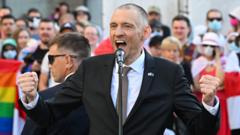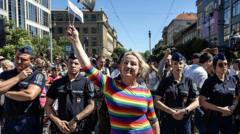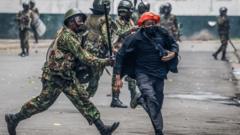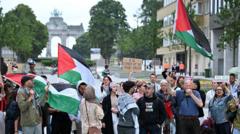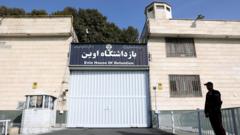The Budapest Pride event has become a pivotal moment in the resistance against governmental oppression, with thousands celebrating diversity and freedom amidst a backdrop of political tension.
Thousands Celebrate at Budapest Pride, Defying Government Censorship

Thousands Celebrate at Budapest Pride, Defying Government Censorship
Lively protest against Orban's impractical ban draws massive crowds, highlighting human rights.
Despite a ban from Prime Minister Viktor Orban's government, up to 200,000 individuals packed the streets of Budapest on Saturday, radiating joy and solidarity during the city's annual Pride parade. The event, which encompassed the historic Elisabeth Bridge and the banks of the Danube River, transformed from a typical pride celebration into a grand expression of civil rights, as participants voiced strong opposition against government policies that undermine freedoms.
Previously held alongside a significantly smaller crowd of 35,000, this year's turnout was dramatically enhanced by Orban's attempts to suppress the event. Many attendees mentioned that the government's actions motivated them to join a cause they may have otherwise overlooked. Vibrant banners dotted the procession, some humorously indicting Orban with messages like, "In my history class, I learnt enough to recognize a dictatorship. You don't need to illustrate it - Vik!" Others depicted the prime minister in a flamboyant manner, wearing makeup and bright colors.
Mayor Gergely Karacsony joined the festivities, indicating that the procession was a powerful testament to resilience and community spirit. He emphasized the importance of the gathering as more than just a celebration of Pride, but a stand for the fundamental rights of all citizens. This defiance against a central government that attempted to impose restrictions drew wide applause and cheers from the diverse assembly.
Orban's government had previously passed legislation that controversially linked LGBTQ+ representation to child protection, causing considerable unrest within Hungarian society. Though police initially justified a ban over concerns for children's exposure, the mayor cited legal precedents that permitted council-organized events to continue unhindered. Through strategic public communication, the police maintained a watchful but reserved role during the festivities.
While Orban maintained a public appearance at a police graduation ceremony on the day of the parade, the pro-government media conducted scathing attacks on the event, branding it as chaotic and a perversion of public order. The implications of the march may soon arise in court proceedings that could redefine the contours of freedom of assembly in Hungary, as the ongoing confrontation between civil liberties and state authority continues to unfold.
Previously held alongside a significantly smaller crowd of 35,000, this year's turnout was dramatically enhanced by Orban's attempts to suppress the event. Many attendees mentioned that the government's actions motivated them to join a cause they may have otherwise overlooked. Vibrant banners dotted the procession, some humorously indicting Orban with messages like, "In my history class, I learnt enough to recognize a dictatorship. You don't need to illustrate it - Vik!" Others depicted the prime minister in a flamboyant manner, wearing makeup and bright colors.
Mayor Gergely Karacsony joined the festivities, indicating that the procession was a powerful testament to resilience and community spirit. He emphasized the importance of the gathering as more than just a celebration of Pride, but a stand for the fundamental rights of all citizens. This defiance against a central government that attempted to impose restrictions drew wide applause and cheers from the diverse assembly.
Orban's government had previously passed legislation that controversially linked LGBTQ+ representation to child protection, causing considerable unrest within Hungarian society. Though police initially justified a ban over concerns for children's exposure, the mayor cited legal precedents that permitted council-organized events to continue unhindered. Through strategic public communication, the police maintained a watchful but reserved role during the festivities.
While Orban maintained a public appearance at a police graduation ceremony on the day of the parade, the pro-government media conducted scathing attacks on the event, branding it as chaotic and a perversion of public order. The implications of the march may soon arise in court proceedings that could redefine the contours of freedom of assembly in Hungary, as the ongoing confrontation between civil liberties and state authority continues to unfold.


